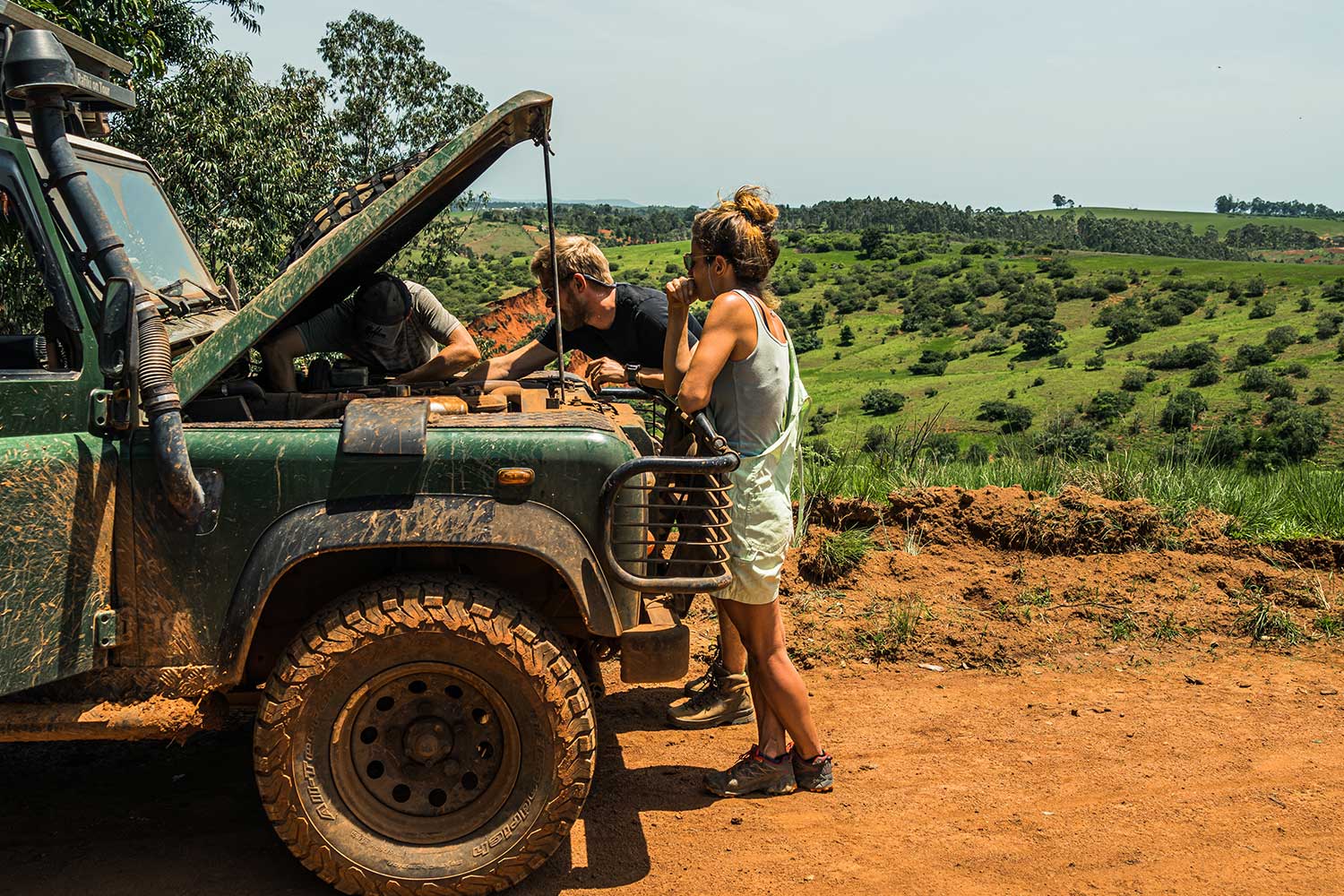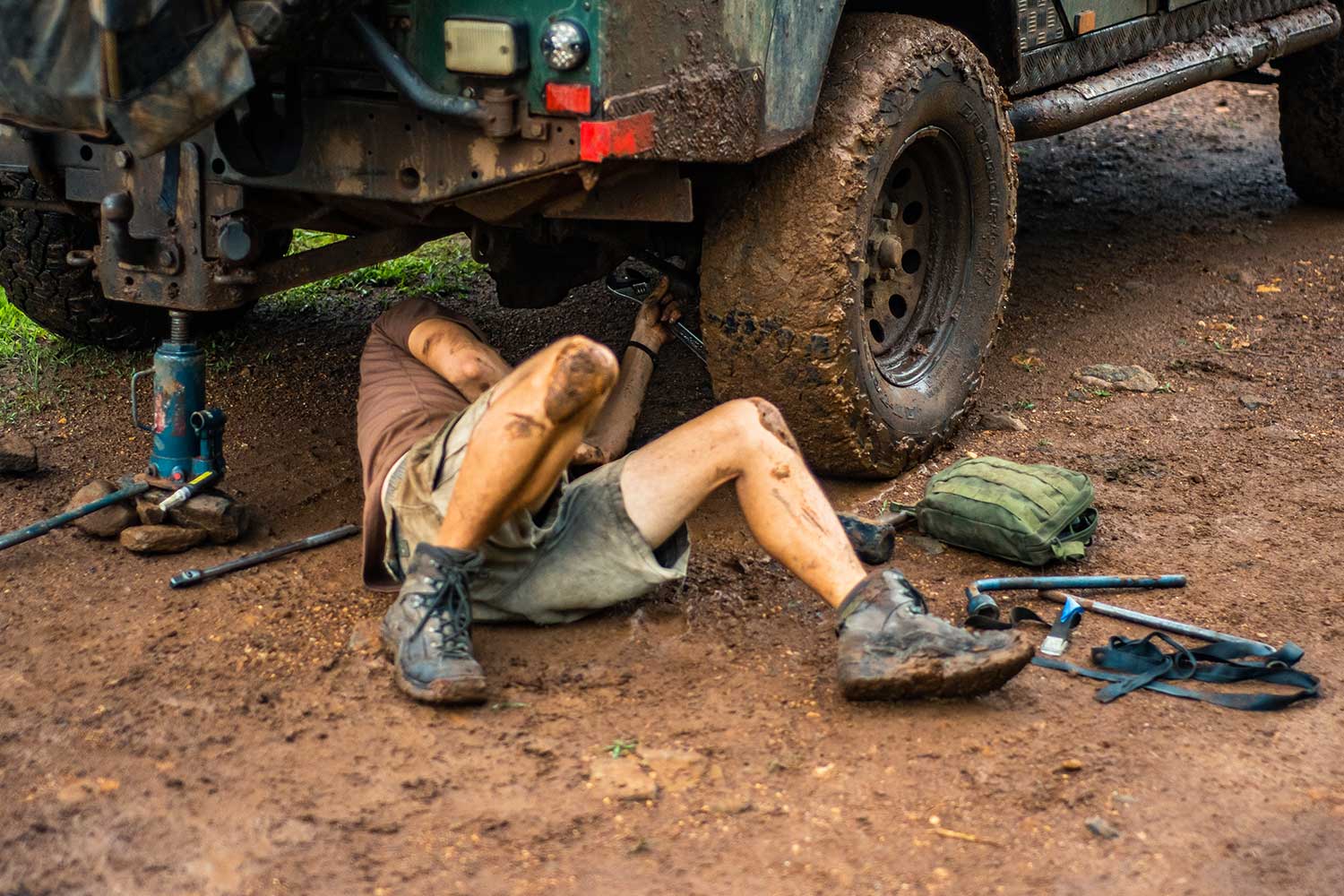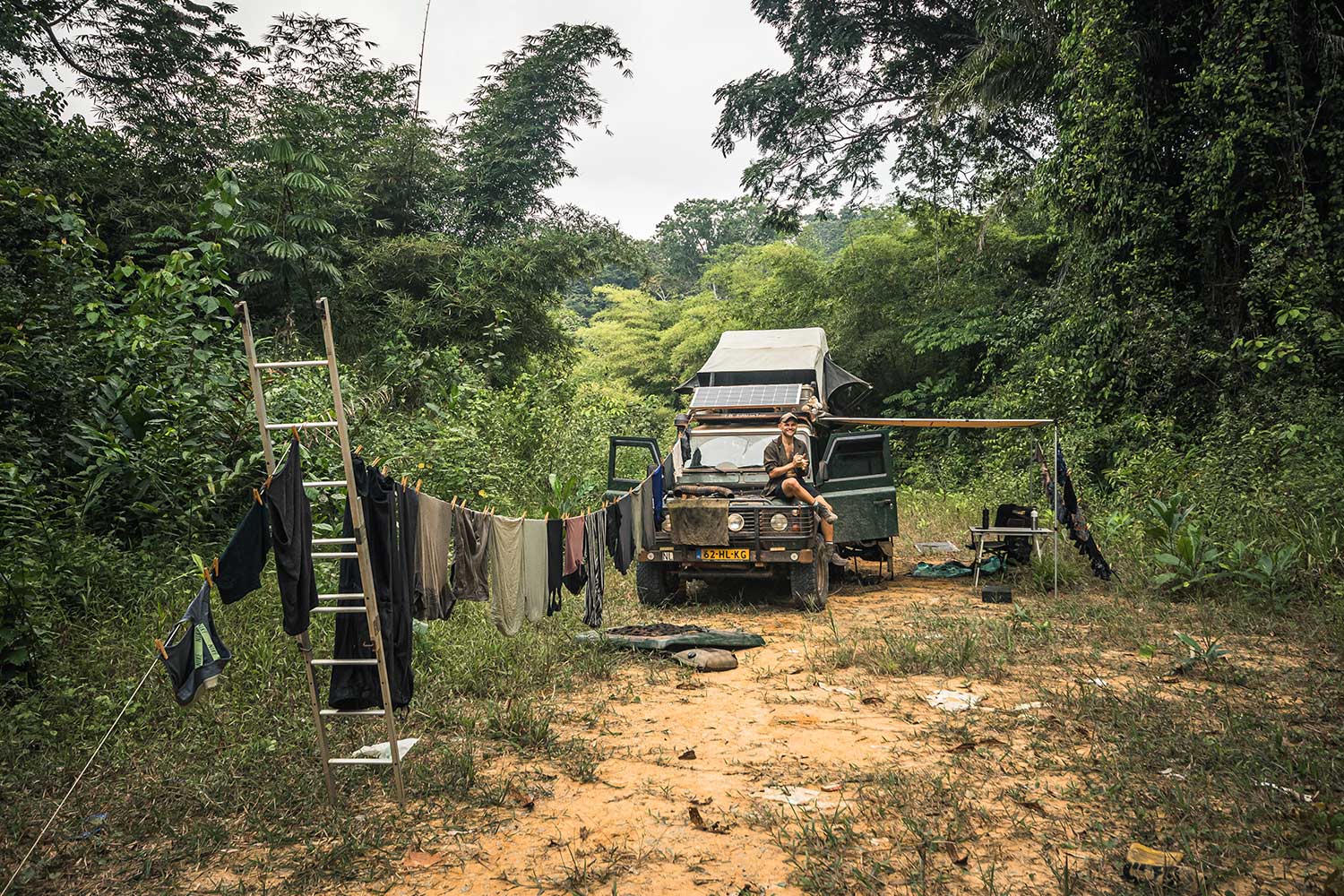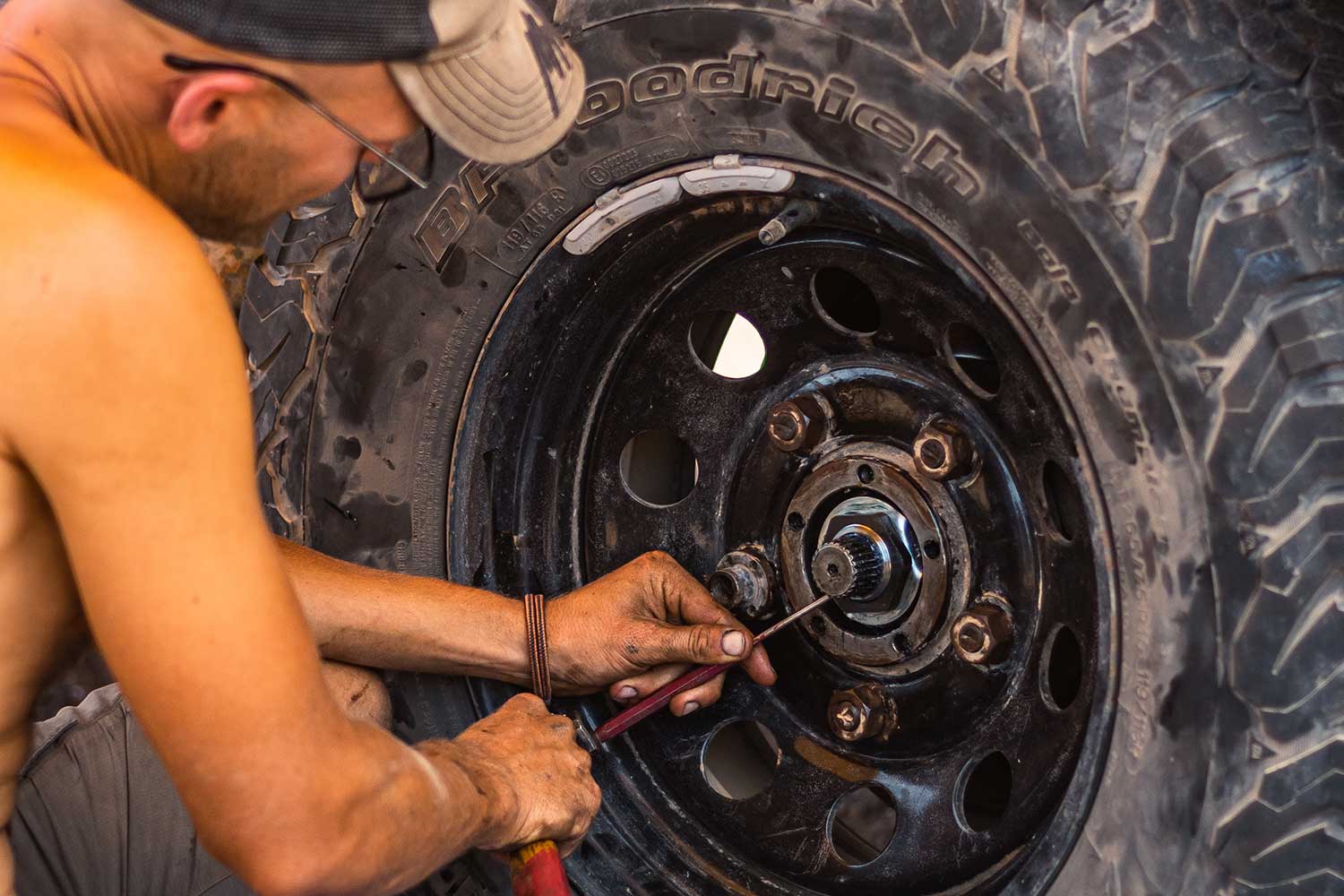Gain basic mechanical knowledge
In our opinion, it is essential to have basic mechanical knowledge when overlanding. Luckily you don’t have to own a mechanic’s degree to have the proper skillset to start overlanding responsibly. It’s all about the mindset, the willingness to learn, and the acceptance to make mistakes. Throw in some creativity and you’ll get a long way.

Learn from your local mechanic
If you don’t have the mechanical skills yet, it’s time to learn. A good way to start is to stay with your local mechanic when he’s working on your vehicle. Not all workshops allow you to, so find one that’s trustworthy and has a personal touch. They will most likely let you stay, especially if you tell them about your plans. You’re not there to supervise but to gain knowledge and learn about their approach. Hopefully, they will show you some tricks and explain why they are doing certain things. Maybe they’ll even go over the vehicle with you. It’s often professional mechanics that know the strengths and weaknesses of specific brands. They might be able to provide you with extra tips and tricks for on the road.
Do the repairs and improvements yourself
Another great way to learn about vehicle basics is to do the work yourself. For us, Rafiki is an old-school Land Rover. Our Defender is simple, and there are no complicated components, nor is there anything electronic. When starting, it’s always helpful to have a local mechanic on standby. Keep in mind that not all mechanics are happy to fix customer’s mistakes though. Having a mechanically inclined friend, or a friendly mechanic, is amazing to have around! Start small, and think every step through. Don’t rush it, and if possible, download some workshop manuals. For Land Rovers, it’s incredibly easy to find workshop manuals, as well as a plethora of YouTube videos explaining everything to the smallest detail.
Mechanical information sources
- Workshop manuals (Land Rover)
- Trailerfitter’s Toolbox Videos (Land Rover)
- Britannica Restorations Ltd (Land Rover)
- Euro4x4parts 4x4xpert blog (not all brands are featured)
Over the years we have done most of the work ourselves as we wanted to become familiar with the vehicle. We started small and worked up our skillset to the point that we felt comfortable doing a full engine overhaul. These days it helps us tremendously to overland into the wild. We know that if a problem arises, we might be able to help ourselves out of a gnarly situation.

Stuck in the jungle
Time for a little story, something that will hopefully inspire you to gain knowledge about your vehicle. We’ll also throw in some DIY bush solutions that might help you one day.
During our crossing of Central Africa, we found ourselves in a bit of a pickle in the beautiful jungle country of Gabon. Just when we started our expedition to cross the country East to West, on the unknown tracks of the South, our engine’s core plug started leaking and we were unable to source the correct part. We quickly found out that Land Rovers weren’t plentiful and if we were to find a part, it would be in the capital of Libreville. Unfortunately for us, that was a mere 700 km away.
An initial search on iOverlander, and through friends, indicated that Land Rover parts aren’t readily available in the country. Like, at all. A huge problem, as that meant we had to arrange the parts overseas. We quickly reverted back to trusted stores in Europe, had it shipped out via DHL, and we tried to make our way towards the capital to pick up that package once it arrived. Yes, we started that 700 km jungle crossing with a leaking plug as there was no other solution.
Over 10 days, we made our way over mountains, into valleys, and through Gabon’s thick lush jungle. A daunting undertaking that almost got the better of us. During the adventure we had to repair the core plug multiple times, using a range of epoxy glues and liquid metal putty. Each fix brought us closer to our goal but was also accompanied by a huge amount of uncertainty, as the fixes would last anywhere between 10 and 100 km. We had to patch that plug multiple times, and every time we had to wait 24 hours for the glue to dry. In the meantime, we were eaten alive by the thousands of insects that loved to suck our blood. Luckily for us, the final repair brought us a whopping 350 km further, all the way to the capital. The metal putty worked best, and we will never leave home without it anymore. Later on, we learned that some bush mechanics sometimes pry the core plug out, and use a piece of round wood instead. If only we had known… Luckily, our ingenuity got us to civilization, and thanks to the reliable parts partners in Europe it was a quick fix only taking about 30 minutes.
Want to hear more about this story? It’s upcoming in a major overland magazine. Keep an eye on our socials to not miss a thing!

DIY solutions
Possessing basic knowledge to assess the problem, and how it impacts safety, can become very important quickly. Having some basic (or advanced) mechanical knowledge, and some general spares, will often get you a long way. Some ingenuity is also never a bad thing. Once you hit the road you’ll soon find out that you have to get creative sometimes. Although not desired when looking at the trustworthiness of your vehicle, you sometimes use what’s around. If you do use a questionable DIY solution, try to fix it properly as soon as you get the chance.
Having said that, we have come to learn that maintaining and improving a vehicle on the road is challenging. Therefore it is best to build a trustworthy vehicle when situations are calm, and access to finances, tools, and materials is available. So improve your vehicle into a trustworthy overlander before you leave, and reap the benefits of that later. Once you start a trip things can become seriously more challenging, and it’s most likely then that you resort to creative DIY solutions to keep the vehicle rolling.
If you happen to find yourself in a pickle and don’t know what to do, or where to go, iOverlander might be a good source of information when looking for spares and mechanics. However, things always tend to break when no one is around and you need to get yourself on the road again. If you are lacking the correct parts or tools, throwing in some DIY solution might be all you need.
It’s for these cases that we always carry the following items:
- Duct tape
- Tie wraps (plastic and metal)
- Metal wire
- Hose clamps
- Canned food (empty cans are ideal for repairing exhausts)
- Assortment of hoses
- Assortment of bolts and nuts
- Dual-component epoxy, and/or metal putty
- Basic tools, including a metal saw and file
Check out our spare parts list for the Defender here.

Grow your confidence and knowledge, stock up, and hit the road
We hope that this blog has shown you the urge to start learning about your vehicle’s mechanics. We believe that knowing the basics will impact your trip positively. It will help you to maintain and improve your vehicle, and you might build confidence to travel further and go where the tarmac ends, and the trails begin.
If that’s not enough for you, don’t forget we are both biologists by study, and are no mechanics by profession. Over the years we have gained the skills to maintain our vehicle and do a full rebuild if necessary. But we’ve only come so far by just doing it, by taking the first step and learning along the way.
Get that wrench and start torquing!





0 Comments